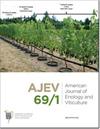推迟发芽以减少冻害:两种葡萄品种的季节性葡萄性能和葡萄酒成分
IF 1.8
3区 农林科学
Q3 BIOTECHNOLOGY & APPLIED MICROBIOLOGY
引用次数: 6
摘要
春季冰冻事件对全球葡萄园生产力构成威胁。我们比较了两种延迟葡萄脱芽避冻的方法,并评估了它们对酚学、产量成分、果实成分和采后参数的影响,包括葡萄酒化学、碳水化合物储存和芽耐冻性。延迟芽裂的两种方法是在8%和10%(v/v)的条件下对休眠芽施用植物油基佐剂(Amigo),并在顶芽达到约Eichhorn-Lorenz第7阶段时进行后期修剪。2018年和2019年对两个葡萄品种Lemberger和Riesling进行了处理,并与没有延迟芽裂策略的对照处理进行了比较。与对照葡萄藤相比,Amigo和后期修剪在年份和品种上都延迟了芽裂。Amigo 8%的芽期延迟为3至6天,Amigo 10%的芽期推迟为5至8天,延迟修剪的芽期为10至11天。2019年,布加勒斯特附近发生了一起冰冻事件。与对照葡萄藤相比,在生长季节测量时,修剪较晚的伦伯格葡萄藤的枝条损伤较小,收获时产量更高。延迟的芽裂处理每年都不会影响葡萄酒的化学成分,或者在接下来的休眠季节持续影响碳水化合物的储存或芽的耐冻性。然而,与对照葡萄藤相比,雷司令的晚熟修剪使丛和浆果重量分别减少了34%和22%。此外,在雷司令葡萄藤上使用10%的Amigo可能会降低芽的存活率。一般来说,晚修剪比Amigo应用更有效地延迟了芽裂,更好地减轻了冻害,而不会对葡萄藤健康或葡萄酒成分产生负面影响;然而,在采用之前,需要考虑后期修剪对簇重的品种依赖性影响。本文章由计算机程序翻译,如有差异,请以英文原文为准。
Delaying Budbreak to Reduce Freeze Damage: Seasonal Vine Performance and Wine Composition in Two Vitis vinifera Cultivars
Spring freeze events pose a threat to vineyard productivity worldwide. We compared two methods to delay grapevine budbreak for freeze avoidance and evaluated their effects on phenology, yield components, fruit composition, and postharvest parameters, including wine chemistry, carbohydrate storage, and bud freeze tolerance. The two methods to delay budbreak were a vegetable oil-based adjuvant (Amigo) applied to dormant buds at 8% and 10% (v/v) and late pruning applied when apical buds reached approximately Eichhorn-Lorenz stage 7. Treatments were applied in 2018 and 2019 on two Vitis vinifera cultivars, Lemberger and Riesling, and compared to a control treatment with no delayed budbreak strategy. Amigo and late pruning delayed budbreak compared to control vines in both years and cultivars. The delay in budbreak varied from three to six days for Amigo 8%, five to eight days for Amigo 10%, and 10 to 11 days later for late pruning. In 2019, there was a freezing event near budbreak. Compared to control vines, late-pruned Lemberger vines had less shoot damage when measured during the growing season and greater yield at harvest. Delayed budbreak treatments did not influence wine chemistry either year or consistently affect carbohydrate storage or bud freeze tolerance in the following dormant season. However, in Riesling, late pruning reduced cluster and berry weight by up to 34 and 22%, respectively, compared to control vines. Furthermore, Amigo 10% may decrease bud survival when applied to Riesling vines. In general, late pruning delayed budbreak more effectively and mitigated freeze damage better than Amigo application without negatively affecting vine health or wine composition; however, the cultivar-dependent effect of late pruning on cluster weight is a consideration prior to adoption.
求助全文
通过发布文献求助,成功后即可免费获取论文全文。
去求助
来源期刊

American Journal of Enology and Viticulture
农林科学-生物工程与应用微生物
CiteScore
3.80
自引率
10.50%
发文量
27
审稿时长
12-24 weeks
期刊介绍:
The American Journal of Enology and Viticulture (AJEV), published quarterly, is an official journal of the American Society for Enology and Viticulture (ASEV) and is the premier journal in the English language dedicated to scientific research on winemaking and grapegrowing. AJEV publishes full-length research papers, literature reviews, research notes, and technical briefs on various aspects of enology and viticulture, including wine chemistry, sensory science, process engineering, wine quality assessments, microbiology, methods development, plant pathogenesis, diseases and pests of grape, rootstock and clonal evaluation, effect of field practices, and grape genetics and breeding. All papers are peer reviewed, and authorship of papers is not limited to members of ASEV. The science editor, along with the viticulture, enology, and associate editors, are drawn from academic and research institutions worldwide and guide the content of the Journal.
 求助内容:
求助内容: 应助结果提醒方式:
应助结果提醒方式:


